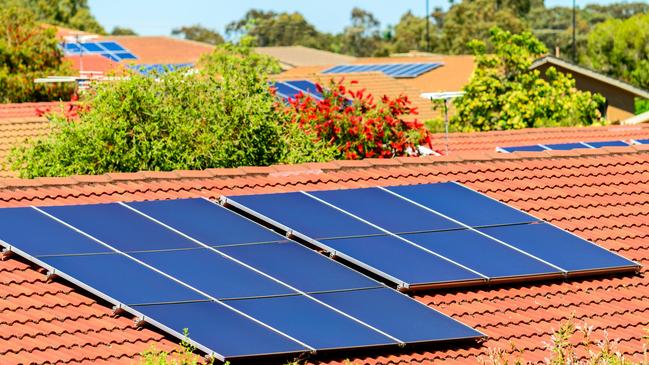Solar panel subsidies costing every family $45 a year
Government subsidies to the one-in-four Australian households that have installed solar panels are adding $45 a year to the average power bill of every family in NSW, new analysis reveals.
Government subsidies to the one-in-four Australian households that have installed solar panels are adding $45 a year to the average power bill of every family in NSW, new analysis reveals.
The Daily Telegraph can also reveal that the price consumers are paying to support green schemes will only get worse, as both sides of politics refuse to accept the competition watchdog’s call the phase them out more quickly.
The Australian Competition and Consumer Commission (ACCC) recommended in its landmark report into power prices in July that the Small-scale Renewable Energy Scheme (SRES) should be dumped by 2021, nine years earlier than its scheduled end date.
The scheme funds incentives for individuals and small businesses to install renewable energy systems including solar panels and hot water heaters, heat pumps, hydro systems and wind turbines.

Analysis by power giant EnergyAustralia indicates that the scheme was currently costing households and business around $1 billion.
The scheme has added $45 to the average NSW power bill so far this year — more than double the average cost of the subsidies in 2017-18 because of the rising number of households installing solar panels.
The EnergyAustralia analysis shows Australia’s eight million households are helping to pay off the solar systems of the two million people who can afford them.
MORE NEWS:
Man charged over bus driver spray attack
Cop punched multiple times as wild brawl breaks out
Virgin denied dog that died on flight was left in sun
And the total cost of the scheme will soar further as long as solar installation rates continue to rise. Opposition leader Bill Shorten’s policy to introduce further subsidies for households that install battery storage for solar systems is forecast to send the cost even higher.
“Unlike other subsidy programs, SRES is not capped which means there is no limit on the amount of subsidy that might be paid by the time it finishes in 2030,” EnergyAustralia chief customer officer Chris Ryan said.
“Our concern is not with solar power — it’s about fairness. With electricity prices at record highs, it’s time to look at whether one group of Australians should be paying more for their electricity than they need to for the privilege of funding other households’ solar systems.”
Both the Morrison government and Labor have ruled out ending the SRES before its current phase out date of 2030.

The scheme, introduced by Labor in 2011, offers households that install solar panels subsidies based on the size of their system. That cash is recovered as an average cost on consumer bills.
The ACCC found the scheme was designed at a time when solar installations were much more
expensive and the “dramatic reduction” in costs meant the case for continuing the subsidies is now “weak”. In 2007, a 1.5kW system cost about $18,000, but a system twice that size now costs just $5,000.
Government analysis indicates phasing out the scheme in 2021 would barely impact the popularity of rooftop solar but could increase the number of installations in the short term.
Energy Minister Angus Taylor defended the scheme and said the biggest cause of price rises in recent years was the big energy companies.
“For too long they have put their record profits ahead of hardworking Australian families and businesses,” he said.
Labor energy spokesman Mark Butler said the ACCC found the households who were able to accessed solar through the SRES scheme had an average saving of $538 per year on their power bills.
“Labor is interested in more way we can help people access the benefits of solar power and increasingly batteries, not at ways to lower solar uptake,” he said.


